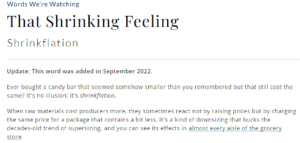Chapter 9: Government Retreat and the Emergence of Post-World War II Prosperity
1. Shrinkflation
This term entered the dictionary in September 2022. Here is the commentary from Merriam-Webster:

![]()

2. The community-property-conversion whipsaw
The movement for common law states to switch to community property ones, in the 1940s, is a full story in its own right. Community property enabled above-average-income married couples to lessen their federal tax liability by 30 percent. States switching from common law to community property after World War II forced the Revenue Act of 1948, which eliminated the common law marriage penalty, reducing higher end married rates in common law states by an effective 30 percent.
The switching of legal regimes, however, was such a wrenching process that states who made the switch, only to switch back after the tax act 1948, baked in legal conundrums for their residents that would be felt for decades to come. If a creditor pursued an individual’s property after a switch back to common law, could half of it be shielded because it was acquired during the community property interregnum? How were single-person titles created during the community property interregnum to be regarded after conversion back to common law? A further matter was the poor quality of these laws. Written in haste with for the sole purpose of forcing the federal hand on the 30 percent tax cut, the minimal legal exactitude of these laws became a troublesome issue for the bar, courts, and legislatures well after repeal into the 1950s. States risked all this before 1948 if the prize was a big federal income tax rate cut.
A law review article canvassing these problems is “Epilogue to the Community Property Scramble: Problems of Repeal,” Columbia Law Review 50, no. 3 (March 1950), 332-351, here.
